Deaths which occurred
on an October 09:
2003 Hayder Yusser, another
Iraqi, and two US soldiers, in an hour-long evening gunfight after
US troops in Baghdad, Iraq, surrounded the Sadr City headquarters or anti-US
Shiite ayatollah Moktada (or Moqtada) al-Sadr, son of ayatollah Muhammah
Sadiq al-Sadr (murdered in 1999 on orders from dictator Saddam Hussein),
who has a private militia, the Jaish Mehdi. 4 US soldiers are wounded.
2003:: 3 policemen, 5 civilians, and two suicide bombers
in a car which explodes at 08:30 when hitting another car in the parking
lot of a police station in Sadr City, the biggest Shiite slum of Baghdad,
Iraq, after crashing through the gate and being fired upon by police. Some
45 persons are injured.
2003 José Antonio Bernal Gómez,
an air force sergeant at Spain's embassy in Baghdad, Iraq, shot at 08:15
by three assailants who chased him from his home, barefoot and in his undershorts.
2003 A US soldier, by a rocket propelled grenade hitting
his convoy at 02:00 in Baqouba, 50 km northeast of Baghdad, Iraq. It is
the 92nd US soldier to be killed in Iraq since USurper-President “Dubya”
Bush pompously declared major combat over on 01 May 2003. Innocent Iraqis
killed at not being counted by the US occupiers.
2003 Baba Jallow,
28, beaten to death by some 10 persons in the town Serekunda, 115 km from
Banjul, Gambia. They believed that he had stolen a man's penis through sorcery.
Reports of penis snatching are not uncommon in West Africa, with purported
victims claiming that sorcerers simply touched them to make their genitals
shrink or disappear in order to extort cash in the promise of a cure. Many
men in Serekunda are now afraid to shake hands. Belief in sorcery is widespread
in West Africa. Seven alleged penis snatchers were beaten to death by angry
mobs in Ghana in 1997.
2002 Dean Harold Meyers,
56, hit in the upper body by a single .223-caliber bullet from high-powered
rifle “X”, shot from a a distance, at 20:18, moments after he
filled his car's gasoline tank at a station in Manassas, Virginia, some
50 km west of Washington, DC. Civil engineer Meyers was on his way home
to Gaithersburg, Maryland, from his job in Virginia. This is the 7th similar
murder in the area in and around DC, from the same rifle. A lot of nonsense
is spouted by news media and the various police forces, who seem clueless.
(Example: they exhort the killer to “stop this madness and surrender”)
2002 Aileen Wuornos, 46, by lethal injection in Florida,
for 6 murders. She was seemingly mentally ill. Her last words were: “I'd
just like to say I'm sailing with the Rock and I'll be back like Independence
Day with Jesus, June 6, like the movie, big mothership and all. I'll be
back”. Wuornos had fired her attorneys and dropped her. Wuornos was
sentenced to death six times for killing middle-aged men in 1989 and 1990,
when she was a prostitute. Her first murder victim was Richard Mallory,
a Clearwater electronics shop owner whose body was found in 1989 in Volusia
County. After standing trial for Mallory's death, Wuornos pleaded guilty
to five other murders in Marion, Pasco and Dixie counties. For years, Wuornos
claimed she shot the men out of self-defense while being raped and sodomized.
Later, she recanted her claims, saying she wanted to make peace with God.
“I'm one who seriously hates human life and would kill again," she
told the state Supreme Court. Wuornos also claimed to have killed a seventh
man.
2002 Two Palestinian boys, aged 12 and 16,
when Israeli soldiers approaching the edge of Rafah in the southern Gaza
Strip fired on a crowd throwing stones and homemade stun grenades.
2001 Four Afghan security guards for a UN contractor, as
US cruise missile destroys the building of a United Nations-funded demining
agency in Kabul, where they were sleeping. It was near the targeted Taliban
radio transmission tower.
2000 Luis Portero, head
prosecutor for the southern Andalucian Superior Court, shot in the head
as he entered his apartment building in Granada shortly after 14:00. The
attack is believed to have been carried out three people, probably of ETA.
Two shots were fired at Portero, at least one hitting him on the back of
the head. He died one hour later in a Granada hospital. — Luis Portero
García, fiscal jefe del Tribunal Superior de Justicia de Andalucía, es asesinado
de un tiro en la nuca a manos de la banda terrorista ETA (Euskadi Ta Askatasuna].
 1995
Sir Alec (Alexander Frederick) Douglas Home, político y aristócrata
británico. 1995
Sir Alec (Alexander Frederick) Douglas Home, político y aristócrata
británico.
1988 Felix Wankel, Germany, inventor
of the Wankel rotary engine (1954) [diagram >], which was
used in Mazda cars. Wankel was born on 13 August 1902. (Everything
you were afraid to ask about the Wankel engine, and rightly so)
1987 Clare
Boothe Luce, of cancer, US ambassador to Italy (in the 1950s),
member of Congress (Republican, 1943-1946), editor of Vanity Fair
(until 1934) 84, author of plays such as The Women (1936, a devoted
wife tries to win back her husband, who had been poached by a saleswoman),
Kiss the Boys Goodbye (1938, a satire on the hoopla surrounding
the search for the feminine lead in the movie Gone With the Wind),
Margin for Error (anti-Nazi), and Abide With Me (1935),
of books Stuffed Shirts (satirical articles about society), Europe
in the Spring (of 1940). She was born on 10 April 1903. Her second
(and last) marriage was in 1935 to Henry R. Luce, publisher of Time
and Fortune, and later also of Life and Sports
Illustrated. Clare Boothe Luce's 1946 conversion to Catholicism followed
conversations with Father (later Bishop) Fulton J. Sheen.
1983:
17 prominent Koreans--including the deputy prime minister and two other
cabinet members--and 2 Burmese. The president of South Korea, Doo
Hwan Chun, with his cabinet and other top officials are scheduled to lay
a wreath on a monument in Rangoon, Burma, when a bomb explodes. Hwan had
not yet arrived so escaped injury, but 17 Koreans--including the deputy
prime minister and two other cabinet members--and two Burmese are killed.
North Korea is blamed.
1974 Oskar Schindler, who saved
Jews.
German
businessman Oskar Schindler, credited with saving 1,200 Jews from
the Holocaust, dies at the age of 66. A member of the Nazi Party,
he ran an enamel-works factory in Kraków during the German occupation
of Poland, employing workers from the nearby Jewish ghetto. When the
ghetto was liquidated, he persuaded Nazi officials to allow the transfer
of his workers to the Plaszow labor camp, thus saving them from deportation
to the death camps. In 1944, all Jews at Plaszow were sent to Auschwitz,
but Schindler, at great risk to himself, bribed officials into allowing
him to keep his workers and set up a factory in a safer location in
occupied Czechoslovakia. By the war's end, he was penniless, but he
had saved 1,200 Jews. In 1962, he was declared a Righteous Gentile
by Yad Vashem, Israel's official agency for remembering the Holocaust.
According to his wishes, he was buried in Israel at the Catholic cemetery
on Mount Zion. |
1967 Ernesto "Che"
Guevara de la Serna, career revolutionary, executed in Bolivia
Ernesto Guevara de la Serna,
better known to the world as "Che" Guevara, is executed by Bolivian
armed forces. Born in Argentina, Guevara was a professional revolutionary
who became involved in the Guatemalan revolution of the 1950s. It
was during this time that he discovered Marxism and became a fervent
convert to the philosophy.
Following
the overthrow of the Guatemalan government by a US-sponsored coup
in 1954, Guevara traveled to Mexico where he joined up with Cuban
revolutionary Fidel Castro. In 1956, Castro, Guevara, and a small
band of supporters landed in Cuba intent on overthrowing its government.
When the initial attack did not succeed, Che joined Castro and the
survivors in the wilds of Cuba, carrying on a guerilla war. In 1959,
the Cuban government fell and Castro seized power. Guevara was put
in charge of finance and economic planning for the revolutionary government.
In 1960 he published Guerilla Warfare, in which he argued
that armed struggle was necessary to free the masses from capitalistic
exploitation.
By 1965, he faded
from public life in Cuba for reasons still not entirely clear. He
then reappeared in 1966 in Bolivia where he hoped to bring about a
revolution. In October 1967, he was captured and executed by Bolivian
troops. This outcome satisfied the US government, under the leadership
of President Lyndon B. Johnson, which viewed him as a dangerous agitator
and had assisted the Bolivian government in its efforts to end Guevara's
challenge.
Despite Che's death
more than 30 years ago, his face is still familiar to millions around
the world, adorning T-shirts, key chains, and posters. He is also
a constant presence in Cuba, with his image painted on walls and buildings
around the nation. |
1958 Pope Pius XII dies, 19 years after elevation to the
papacy. He was later accused of failing to speak out for Jews during the
Nazi era. He formally defined the dogma of the Assumption of the Virgin
Mary (1950). (He would be succeeded by Pope John XXIII.)
1948 Joseph
Wedderburn, mathematician
1935 Archibald Thorburn,
British artist born on 31 May 1860.
1934 King Alexander I
of Yugoslavia, 45, and French Foreign Minister Louis Barthou, 72,
assassinated in Marseilles by Georgief, a Macedonian revolutionary associated
with the Croat separatist Ustasha in Hungary. Alexander and Barthou had
been on a tour of European capitals in quest of an alliance against Nazi
Germany. The assassinations bring the threat of war between Yugoslavia and
Hungary, but confrontation is prevented by the League of Nations. —
Alexander I was of the Karadjordjevic dynasty of Serbia, rivals of the Obrenovic
dynasty.
1928 Ignasi Iglesias, dramaturgo español.
1918 Raymond Duchamp-Villon, escultor francés.
1912 Millie & Christine, 61, Siamese twins
1907
William Lundsay Windus, British painter born in 1822. — MORE
ON WINDUS AT ART “4” OCTOBER
with links to images.
1894 Norbert Goeneutte, French
painter born in 1854. — MORE
ON GOENEUTTE AT ART “4” OCTOBER
with links to images.
1886 (08 Oct?) José María Casado
del Alisal, Spanish painter and illustrator born on 24 March 1831.
— MORE
ON CASADO AT ART “4” OCTOBER
with links to images.
1871 Most
of the 300 killed by the Great Fire of Chicago [Click here for aerial view of the burnt district]
At nine o'clock on the previous evening,
a Sunday, the Great
Fire of Chicago broke out in southwest Chicago, possibly started
by a cow kicking over an oil lamp in a barn owned by Patrick and Katherine
O'Leary. Within hours the conflagration, driven by a strong wind out
of the southwest, engulfs the center of the city, and around midnight
jumps the Chicago River, burning the southern portion of the city
to the ground by daybreak.
As
thousands of panicked Chicagoans flee to the north, the fire pursues
them, and today, Monday, the flames reach Fullerton Avenue, then the
northern-most limit of the city. Tuesday morning a saving rain begins
to fall, and the flames finally die out, leaving Chicago a smoking
ruin, with some 300 dead, 17'450 buildings destroyed in an area over
6-km-long and 1-km-wide, the original Emancipation Proclamation destroyed,
and 98'500 people left homeless. The material damage is estimated
at $200 million.
Several factors
contributed to the severity of the Great
Chicago Fire. The bustling Midwestern city was built primarily
of wood, and several woodworking industries operated within the city
limits. Also, rainfall during the preceding months had totaled just
one fourth of normal precipitation while early October was unseasonably
warm.
Despite the devastation,
Chicago would rise again and continue to be the economic center of
the American West for decades to come. While, geographically, Chicago
is a midwestern city, economically it is the unofficial regional capital
and economic center of the American West. Because of its location
on the western edge of a system of lakes, rivers, and canals that
link the city to the East, Chicago was the natural destination for
both western raw materials moving East and eastern manufactured goods
moving West.
After the Civil
War, Chicago quickly eclipsed St. Louis as the primary trading hub
between the US East and West, and the city's fate was inextricably
tied to the rapidly growing settlement and development of western
natural resources. Millions of dollars worth of cattle, lumber, swine,
and grain that had originated in the plains of Wyoming or the mountains
of Montana were channeled through the massive freight yards, slaughterhouses,
and grain elevators of Chicago. A look at a map of the US during the
1880s reveals that, by the late 19th century, all railroads led to
Chicago. Although the Great Fire of 1871 destroyed Chicago's downtown,
it left most of the city's essential industrial infrastructure in
place. Its towering grain elevators and vast stockyards continued
to collect the growing output of the West, process it into pork sausages
or two-by-fours, and send it onward to the insatiable markets of the
East. |
1864 Nine Yanks and many Rebs
at Battle of Tom's Brook
^top^
Union cavalry in the Shenandoah Valley deal a humiliating defeat to
their Confederate counterparts at Tom's Brook, Virginia. Confederate
General Jubal Early's force had been operating in and around the Shenandoah
area for four months. Early's summer campaign caught the attention
of Union General-in-Chief Ulysses S. Grant, who was laying siege to
Richmond and Petersburg, Virginia. Grant was determined to neutralize
Early and secure the Shenandoah for the North. He dispatched one of
his best generals, Philip Sheridan, to pursue the Rebels there.
Sheridan took command in August but
spent over a month gathering his force before moving against Early.
He quickly turned the tables on the Confederates, scoring major victories
at Winchester and Fischer's Hill in September. Early's battered force
sought refuge in the foothills of the Blue Ridge Mountains, while
Sheridan began systematically destroying the Shenandoah's rich agricultural
resources. Sheridan used his cavalry, under the command of General
Alfred Torbert, to guard the foot soldiers as they burned farms and
mills and slaughtered livestock. Confederate cavalry chief General
Thomas Rosser nipped at the heels of the marauding Yankee force, but
Torbert refused to allow his generals, George Custer and Wesley Merritt,
to counterattack. He insisted they continue to stick close to the
Union infantry. Sheridan heard of this and demanded that Torbert attack.
At dawn on October 9, Custer
and Merritt and their respective forces attacked the two wings of
the Confederate cavalry. Merritt's 3500 Yankees overwhelmed General
Lunsford Lomax's 1500 soldiers, but Custer had more difficulty. His
2500 men faced 3000 under the command of Rosser, who was, coincidentally,
a close friend of Custer's at West Point before the war. Custer observed
that the Rebels were protected by the high bank of Tom's Creek, so
he sent three of his regiments around Rosser's flank. Both groups
of Confederates broke in retreat. The Yankees pursued the defeated
Confederates for over 30 km, a flight called the "Woodstock Races."
The chase ended only when the Confederates reached the safety of Early's
infantry. The Yankees captured 350 men, 11 artillery pieces, and all
of the cavalry's wagons and ambulances. Nine Union soldiers were killed,
and 48 were wounded. It was the most complete victory of Union cavalry
in the eastern theater during the entire war. |
1849 Frédéric Frégevize, Swiss artist born in 1770.
1841 Karl Friedrich Schinkel, German painter and architect
born on 13 March 1781. — links
to images
1815 Louis Auguste Brun de Versoix,
Swiss artist born on 03 October 1758.
1807 Malfatti,
mathematician
1806 Benjamin
Banneker, 74, astronomer/mathematician
1747
David Brainerd, 29, of tuberculosis (brought on by exposure). Colonial
missionary to the New England Indians. Following his death, the publication
of Brainerd's
Journal by Jonathan Edwards influenced hundreds to become missionaries
after him, , including the "father of modern Protestant missions,"
William Carey..
before 1704 Oct 9 Jan Pauwel Gillemans Jr.,
Flemish artist born on 03 September 1651.
1562 Gabriel Fallopius, Modena Italy, anatomist
1537 Hans Cranach, German painter and draftsman, born in
1513. — more
1469 Filippo Lippi, fraile
pintor italiano.
1390 Juan I, Rey de Castilla y
León.
1253 Robert
Grosseteste, mathematician, English reform-minded bishop who
was a strong supporter of the Franciscans, exerted influence on Wyclif,
and first formulated the scientific method.
1047 Pope Clement
II, probably poisoned.
0680 Husain ibn 'Ali,
Shi'i religious leader, enters martyrdom |
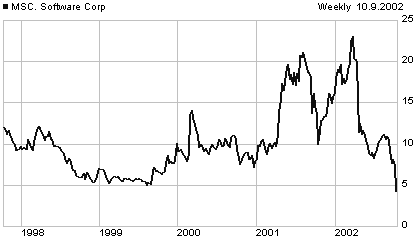 On
an October 09:
On
an October 09: 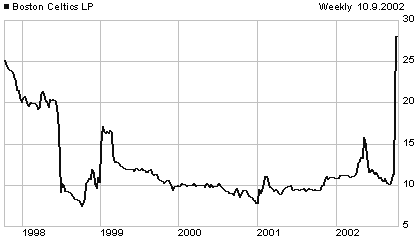 2002
The shares of the Boston Celtics Limited Partnership (BOS) surge on the
New York Stock Exchange, where they trade for the first time since they
closed at $11.35 on 27 September. They open at $29.50, the intraday high,
and close at $28.00. Only 28'400 of the 2.7 million shares are traded, but
usually it is a rare day when more than 2000 shares of BOS are traded. The
basketball team is 52% owned by a group led by Paul Gaston, and 48% is the
traded shares of BOS owned by fans. The franchise is the only US professional
sports team to be publicly traded. After the close of trading on 27 September
2002, venture capitalists Stephen Pagliuca, and father and son Irving and
Wycliffe Grousbeck, announced plans to pay $360 million to purchase the
team, whereupon trading was stopped. The public shareholders would receive
$25 to $35 per share, it was estimated on 07 October 2002. [< 5~year
price chart]
2002
The shares of the Boston Celtics Limited Partnership (BOS) surge on the
New York Stock Exchange, where they trade for the first time since they
closed at $11.35 on 27 September. They open at $29.50, the intraday high,
and close at $28.00. Only 28'400 of the 2.7 million shares are traded, but
usually it is a rare day when more than 2000 shares of BOS are traded. The
basketball team is 52% owned by a group led by Paul Gaston, and 48% is the
traded shares of BOS owned by fans. The franchise is the only US professional
sports team to be publicly traded. After the close of trading on 27 September
2002, venture capitalists Stephen Pagliuca, and father and son Irving and
Wycliffe Grousbeck, announced plans to pay $360 million to purchase the
team, whereupon trading was stopped. The public shareholders would receive
$25 to $35 per share, it was estimated on 07 October 2002. [< 5~year
price chart]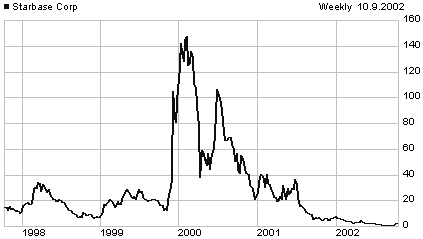 2002
On news that Borland (BORL) is to buy for $24 million ($2.75 a share) the
computer software (CaliberRM, Code Wright, eXpressroom) corporation Starbase
(SBAS), the SBAS shares skyrocket, on the NASDAQ, from their previous close
of $0.80 to an intraday high of $2.72 and close at $2.69, on a volume of
2 million of its 8.7 million shares. At the close the bid is $0.01 and the
asked $2000.00 (!!!) SBAS had traded as high $161.25 on 07 February 2000
and, within the last 52 weeks as high as $7.97 on 18 October 2001 and as
low as $0.52 on 21 August 2002. [5~year price chart >]
2002
On news that Borland (BORL) is to buy for $24 million ($2.75 a share) the
computer software (CaliberRM, Code Wright, eXpressroom) corporation Starbase
(SBAS), the SBAS shares skyrocket, on the NASDAQ, from their previous close
of $0.80 to an intraday high of $2.72 and close at $2.69, on a volume of
2 million of its 8.7 million shares. At the close the bid is $0.01 and the
asked $2000.00 (!!!) SBAS had traded as high $161.25 on 07 February 2000
and, within the last 52 weeks as high as $7.97 on 18 October 2001 and as
low as $0.52 on 21 August 2002. [5~year price chart >]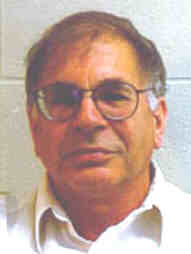
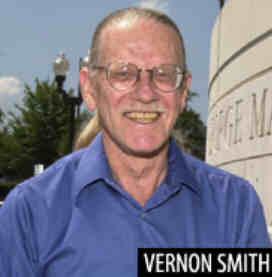
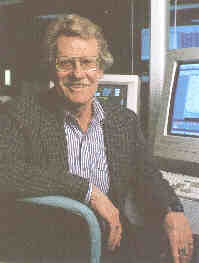
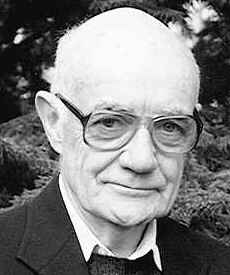
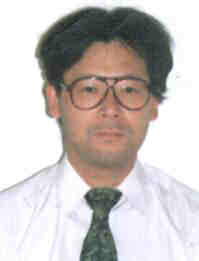
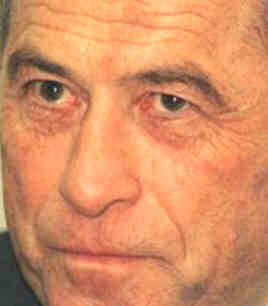
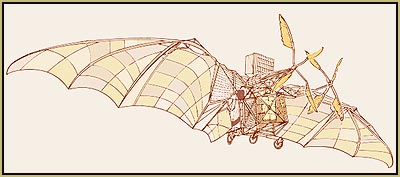 1890
Premier vol de Clément Ader
1890
Premier vol de Clément Ader 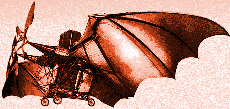
 1779 Luddite Riots being in Manchester, England in reaction
to machinery for spinning cotton.
1779 Luddite Riots being in Manchester, England in reaction
to machinery for spinning cotton. 
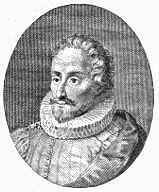 Liberado,
en 1604 marchó a Valladolid --población en la que residía
la corte filipina--, y fijó allí su residencia. Un año
después, en 1605, apareció por fin publicada la primera
parte del Quijote.
Liberado,
en 1604 marchó a Valladolid --población en la que residía
la corte filipina--, y fijó allí su residencia. Un año
después, en 1605, apareció por fin publicada la primera
parte del Quijote.